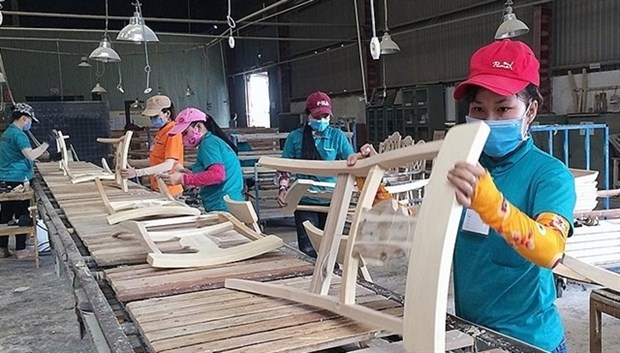Vietnam's wood exports decrease as inflation increases
Vietnam's exports of timber and wood products have decreased due to the impact of high inflation in the export market, according to the Ministry of Industry and Trade.
According to the General Department of Customs, Vietnam's export value of timber and wood products in June fell by 4.9% on-year to US$1.5 billion. Timber exports in June were estimated at more than US$1.03 billion, down 18.1%.
In the first six months, the export value of timber and wood products surged by 2.8% on-year to US$8.5 billion. But the export value of wood products plunged by 4.6% on-year to US$6 billion.
Wooden furniture was the key export item in the structure of export timber and wood products in the first five months of this year. However, the export value decreased due to slowing global demand
The impact of the COVID-19 pandemic, the “zero COVID policy” in China and the high input costs due to the Russia-Ukraine conflict caused many countries to face high inflation, so consumers must tighten their spending to decrease demand for non-essential goods like wood products.
Those factors made Vietnam's export value of timber and wood products plunge in the first half of this year.
Nguyen Liem, Chairman of the Binh Duong Furniture Association (BIFA) and general director of Lam Viet Joint Stock Company, said that rising inflation has made consumers in export markets such as the US and EU spend on essential items first. So, his company has faced reducing orders from some partners.
In addition, the lower wood export turnover in the first half was also due to very high logistics costs. Even the value of wooden products in the containers exported to the US market is much lower than the shipping cost. For example, in some US ports, the freight of one container is now around US$20,000. Meanwhile, the value of wood products in this container is about US$13,000-15,000.
High shipping costs lead to a tendency to move orders to neighbouring countries like Mexico to take advantage of geographical distance.
Nguyen Chanh Phuong, Vice Chairman of the HCM City Fine Arts and Woodworking Association (HAWA), said the US market accounts for 60% of the export value of Vietnam's timber and wood products. Vietnam's wooden furniture exports to the US market are mainly cheap products.
High US inflation has caused low- and middle-income groups to tighten their spending, creating a significant impact on Vietnam's wood product exports, he said.
The local wood industry's enterprises have begun to have signs of a lack of orders from the US market, while some other big markets, such as the EU and the Republic of Korea, have also started showing difficulties due to inflation.
The lower export turnover of timber and wood products in the first half of 2022 has worried the wood industry, particularly regarding the export growth target this year.
Nguyen Liem said that the wood industry was now one of the goods items gaining high export growth. However, the export growth rate has been lower than the figures in the previous years.
This year's timber and wood product export turnover growth is forecasted only to reach 5-7%. It will be challenging to get 19% growth in 2021, Liem said.
That situation is partly due to the 20 to 60% higher price of input materials over the same period last year. This reduces enterprise competitiveness even with technical improvements to increase labour productivity, he said.
He added that the room for export growth was not large unless there was a breakthrough such as digitisation, automation, or more use of domestic wood.
Experts are currently cautious in forecasting the growth of export timber and wood products this year.
In the context of high inflation that has not shown any signs of cooling globally, businesses are also reviewing orders to achieve the most efficiency in production and business and keep their client.
In addition, Do Xuan Lap, Chairman of the Vietnam Timber and Forest Products Association, said a problem for the wood industry today was that Vietnam needed to develop a large, high-quality domestic wood raw material source to maintain its competitive advantage.
Nguyen Quoc Tri, Director of the General Department of Forestry, said the department would coordinate with associations in the wood industry to solve the problem in raw materials.

